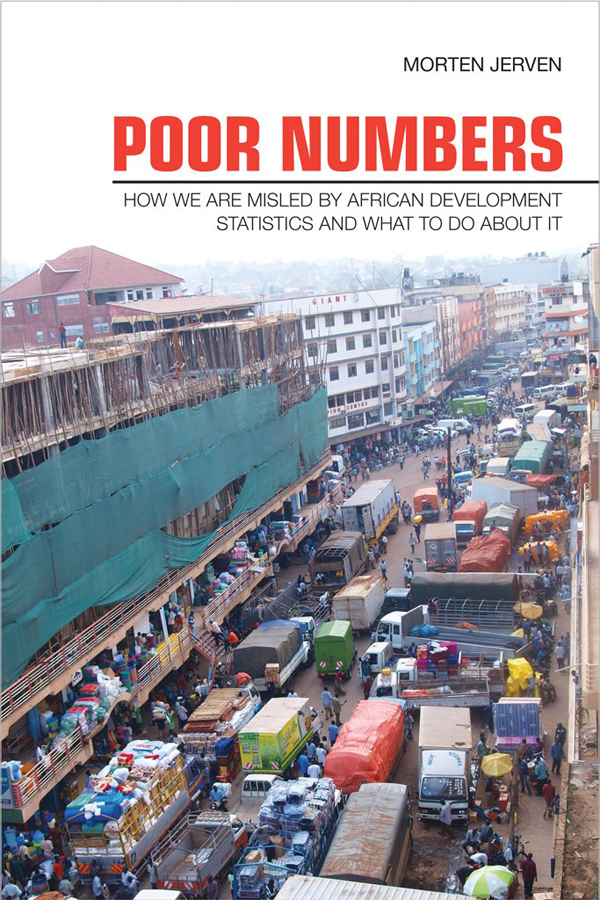Poor Numbers: How we are misled by African development statistics and what to do about it

Statistical indicators are extremely important. They fundamentally shape what we know about the world and how we perceive and evaluate development. They represent the most synthetic as well as the most common measure of the progress that one economy is making.
Statistics on African economies are widely known to be inaccurate, and yet, this book represents the first systematic attempt in “opening the black box of African statistics” and to understand the production of African data and its role in policy making. The book is essentially written for “data users”. It offers an assessment of the extent of the inaccuracy in development economic statistics, the policy implications of these problems and finally, it puts forward some policy suggestions that could remedy this unsustainable situation.
Jerven demonstrates, with sobering clarity, that most African governments chronically produce imprecise and inaccurate economic statistics. Lack of basic data is striking, as well as the use of rudimentary methods. They are producing “poor numbers”, and not only in terms of technical accuracy, which are then used to make critical decisions on how to allocate scarce resources. Data is based on “educated guesses, competing observations and debatable assumptions”. Therefore, governments are not able to make informed decisions. Despite the fact that data are seriously misleading, there is no transparent public debate around this issue. Jerven further stresses that “it is important to note that “poor numbers” are not a problem that is unique to Africa. The larger problem of the politics of accuracy of numbers is neither geographically specific to Africa nor exclusive to debates on economic development”.
Beside the introduction and conclusion, the book is divided into four chapters.
In the first chapter, Jerven identifies and describes a problem with African statistics. It seems that even when it comes to some of the basic and the most vital variables for the economic and social analysis of African countries (total population, agricultural production and change in national income) data are highly problematic. He clearly points out that African GDP data are affected by serious problems of reliability, accuracy and volatility. Entire subsectors of some economies are left out, while others are assumed not to have changed over the last couple of decades. The most significant event to affect the reliability of data over the last couple of decades was the informalization of economic activities. Distinction between recorded and unrecorded economic activity exists in all economies, but, in most African economies the unrecorded economy is so large and so relevant that to leave it out is completely unacceptable. On the other hand, its inclusion into the national accounts has been constrained by the missing data.
The second chapter offers a short overview of the establishment and the evolution of the national income accounting in Sub-Saharan Africa and, among other things, it argues that income statistics needs to be fully historicized and contextualized. It shows a certain degree of continuity in the conceptual problems faced by statisticians inpatient to apply original frameworks initially developed for industrialised countries to complex African realities. More importantly, it points out that the quality and coverage of statistics in Sub-Saharan Africa has closely mirrored the fate of the states producing them.
In the third chapter of the book, Jerven draws more explicit links between statistics and state capacity. Political economy in which facts are embedded does matter. Data collection is often in accordance with governance imperative. Unfortunately, most African governments are too preoccupied with their own political survival, and rather than with “technocratic agents pursuing development per se”. The accuracy of data is, in most cases, a very low priority for politicians and, unfortunately, political priorities signal statistical priorities.
Fourth chapter sheds a light to the institutional, political and financial framework in which African statistical offices operate. They are usually underfunded and understaffed, and in a weak position to inform policy making with updated and accurate information. At the same time, independence of statistical offices is one of the main preconditions for acquiring a high quality data.
Finally, Jerven puts forward some policy recommendations that could improve this grim state of affairs. They are board in scope, reflecting the conceptual, institutional and political nature of the problem.
Starting point should be drawing attention to data deficiency. The next step should be preparation of the new baseline estimates for African economies which will be based not solely on international standardization, but also on local conditions and local applicability.
In the centre of the reform, Jerven sees strengthening and empowering of national statistical offices. Additional funding should be made available for reliable, frequently disseminated smaller surveys.